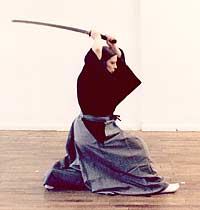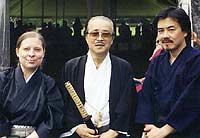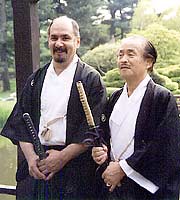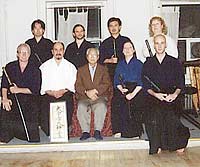The Study Of Iaido
by Deborah Klens-Bigman, Ph.D.

Editor's Note: This is the first
in a continuing series of articles on the Japanese art of iaido the
modern discipline or way of drawing the sword that was popularized in
the 1930's. It was derived from iaijutsu, a sub-specialization of kenjutsu
(sword arts) that was practiced by professional (samurai) warriors and
involved methods of drawing the sword and cutting as a single motion.
Future articles will focus on concepts that relate to practice and then
on specific analyses of kata and basic techniques.
| |
| Otani Yoshiteru,
founder of New York Budokai |
Iaidoka - those who study the art of drawing the Japanese traditional
long sword - are used to people asking why they study. Next to kyudo
(long bow archery), iaido is probably the most esoteric martial art
form. Iaido is very formalized, involves almost no competition and takes
a long time - perhaps a lifetime - to learn. As an art form, it is closer
to calligraphy than karate or judo, for example.
While practitioners have described what iaido practice entails (including
my essay elsewhere on this website) not many people can really answer
the question of why we do it. I have noticed recently that even iaidoka
themselves are not of a uniform opinion. Rather than lay out practitioners'
pro's and con's and support or refute each point in turn, I offer here
my own personal take on what it means to study this alternately satisfying
and frustrating art form.
| |
| Deborah Klens-Bigman performing
at an iaido demonstration |
For some context, I suppose I should mention that I started iaido sixteen
years ago. I had some background in Western fencing, but no Asian martial
arts experience at all. I liked samurai movies, and thought it would
be cool to learn the techniques, once I found out they existed beyond
combat choreography.
The dojo I chose and have stayed with, New York Budokai, like most
iai groups, is small. While some martial artists boast trophies or medals
earned in the heat of sparring competitions, with very few exceptions,
iaidoka have virtually nothing to show for ourselves.
While there are some kata competitions, there is, understandably, no
sparring in iaido, no cash prizes, no film contracts (okay, except for
Peter Weller, but that was some time ago). At NYB, we not only don't
enter competitions as a general rule. We don't even wear patches on
our gi (I suggested a Jolly Roger once, but no one else liked the idea).
We wear only black, blue or white practice clothes. We have dan rankings,
but the basic belt colors are white and black.
 |
| Klens-Bigman, Otani Sensei
and Stanley Chin - two generations of practice |
As I said, iaidoka themselves are hardly in agreement
over their reasons for study. Some, perhaps embarrassed to admit they
like Japanese slice 'n dice movies, repeat the mantra that iaido practice
is for "self improvement." Others deplore such "cultural
baggage" and insist iaido training simply teaches proper use and
handling of a traditional weapon. Others cite interest in history or
traditional Japanese culture as a motivation. "Self-defense"
does not usually enter into the discussion, since most of us do not
keep our swords ready for use at all times.
| "Anyone can learn to kill someone.
Living is a lot more difficult." |
For my part, the reasons for doing iaido include all of
the above, and more besides. That iaido, properly taught, teaches proper
use and handling of the Japanese sword should be a given, but swordsmanship
is only the outermost layer of practice. As my teacher Mr. Otani has
said, anyone can learn to kill someone. Living is a lot more difficult.
Ideally, there are prerequisites for studying iaido (or at least there
should be). Probably the most important of these is sincerity of heart.
I can't altogether say this is easy to do in the 21st century U.S.A.,
but we try our best.
Once, I saw a Japanese classical dance teacher yell at one student
after another. She paced the floor, chain-smoking cigarettes, almost
in tears, shouting "Dame' dame' dame'! Dekinai" ("Bad!
Bad! Terrible! You can't do it"). I was floored by this performance.
I next expected her to order the student out of the studio forever.
She didn't.
| "A Japanese teacher who kicks a student's
butt around the room is paying tribute to her sincere desire to
learn and potential to improve." |
It took awhile, but I have learned that a Japanese teacher who kicks
a student's butt around the room is paying tribute to her sincere desire
to learn and potential to improve. A Japanese teacher who tells a student
something is "fine," and moves on, has decided the student's
interest or potential is somehow less than genuine, and won't bother
with him.
 |
| Otani Sensei with Philip
Ortiz, Chief Instructor of New York Budokai |
|
While American teachers are more concerned with
an individual's varied learning capabilities than a traditional
Japanese teacher, even American teachers who are able to make
a choice would pick the student eager to learn over one who has
something to prove. I have spoken to more than one Western martial
arts teacher who admitted ignoring a student he didn't care for
in the hope that he would take the hint and go elsewhere. Perhaps
Western and Japanese teachers aren't so different after all. |
Likewise, an uncontrollable temper in a sword class is not an option.
Sword techniques, once learned, can be blazingly fast, and a lot more
deadly than a punch thrown in anger. Formality is not only for safety
in learning iaido techniques, it is a defense against thugly elements
that are all too common everywhere today. Students who cannot follow
simple rules of etiquette or take criticism gracefully have no place
in iaido, and enforcement of etiquette is one way of sorting them out.
| "Martial art study will reveal someone's
personality in more detail than any of us want to see, or know
about." |
Unfortunately, not all dojo consider manners a priority. At least one
teacher I know maintains a fairly open policy, hoping that someone who
begins practice a little rough around the edges will someday shine.
While this can happen, I have not really seen it. More likely, martial
art study will reveal someone's personality in more detail than any
of us want to see, or know about.
In its very basic sense, iaido is the formalized teaching of sword
techniques. It is formal, because that is the safest way to learn it.
Real katana (swords) are razor sharp. An incorrect draw can slice through
the wooden saya (sheath) and into a hand before the iaidoka is even
aware of what has happened. Nowadays most students begin practice with
a bokuto or practice sword. A practice sword, being less sharp, is unlikely
to cut through, but it is certainly possible to carelessly stab yourself
or someone else. Hence, formal slowness has been found to be the best
way to learn.
| |
| Seiza builds skill and teaches
respect. |
In our style, Muso Shinden ryu, 11 of the 12 kata of the first set
begin with the person sitting in a kneeling position of seiza. Why seiza?
It provides stability, literally slowing down the student's movement,
thereby providing a safe framework for learning the basics. Seiza also
strengthens the quads and the back muscles that will aid in learning
techniques.
But there are other reasons for seiza. Seiza is also the most formal
of postures in Japanese traditional culture. Westerners generally do
not grasp the significance of this posture; simply finding it uncomfortable,
they assume it must be only for the practical reasons noted above.
Seiza teaches other important things, for example (often equally incomprehensible
to most Americans, at least) - manners. Sitting in seiza demonstrates
respect - to fellow iaidoka, teachers and the tradition of iaido itself.
Seiza is a physical link to the Japanese traditional past, which created
and refined the art form over 400 years. Seiza is more than a beginning
iaido posture for basic kata. It is part of what Japanese scholars refer
to as "seiza bunka" - seiza culture, which includes other
classical art forms, like calligraphy, tea ceremony, flower arrangement,
even noh and kabuki theatres.
Seiza teaches respect, and also (well known to those who've tried it)
humility. It sounds like a cliche, but barring some actual physical
impediment, I can gauge the depth of a student's interest in learning
iaido by their willingness to adapt and maintain this posture in class.
As those who have struggled with seiza, let alone iaido kata, know,
patience is another lesson of practice. While one could say this about
nearly every endeavor, the iaidoka becomes, and stays, well-acquainted
with her limitations throughout the time of practice, whether for months
or years or a lifetime.
After 16 years, I am still learning kata. The okuiai set, consisting,
in our practice, of 18 forms (kata), is constructed in such a way as
to make any weaknesses in my previous practice readily apparent. As
a beginning student, I used to admire my teachers gliding though these
forms, thinking they didn't look so hard. I was anxious to get through
the basics and learn the cool stuff. Well, without the basics, I can't
even approach the cool stuff. One lesson learned.
Another, more powerful lesson is that iaido takes so long to learn,
by the time you get to the okuiai forms, you are starting to feel the
toll of life on muscles and joints. Maybe my fingers ache a little,
maybe my arms, due to carpal tunnel syndrome unrelated to iai practice,
begin to hurt after a few hours. Damn, just when I thought I was getting
somewhere.
The payoff for patience comes in subtle ways, however. I can see small
differences in technique, which helps me improve. I can detect bad habits
in myself and others, so we can keep making corrections. I take criticism
better (at least I try). I move more efficiently, so I don't conk out
in repetitive exercises like some of the younger guys do. I'm certain
I don't ache as much the next day after a workout.
When I meet a new student who in spite of physical limitations (we
all have them) has a sincere desire to learn, I look for the potential
in his first, awkward movements and see improvements every week.
Iaido can also help develop generosity of spirit. This is particularly
important in a small dojo. All of our students who stay around long
enough know they will have to teach, even if it is only occasionally
and on an informal basis at first.
Service is a way of giving back to the teachers, and more importantly,
the tradition from which we have learned so much. Students who have
practiced enough to achieve dan rank but haven't developed this quality
are rare, though there can always be one who maintains what I call a
"small heart." Such a person eventually finds himself isolated
from the inner life of the dojo. He comes to practice and the teaching
and other responsibilities swirl around him. Usually, though, he won't
even notice the difference.
Iaido also teaches courage, whether you want it or not. Try teaching
a 250-pound beginner a partner kata in which he has to attack you when
he has yet to learn about timing, distance or anything else. Needless
to say, courage goes along with patience.
In spite of all the romantic notions about teachers never getting hit
by their students, all the teachers I know have been bopped pretty good
on occasion. One guy who beaned me on the head because I blocked improperly
(his wooden sword strike), braced himself for what he was certain would
be a retaliatory strike. "Forget it, it was my fault," I said,
as the stars cleared out of my head and flew back to the heavens where
they belonged. (This is not the same as someone deliberately trying
to hurt someone else. While something like that might earn a cuffing
at a karate dojo, it should result in expulsion from an iai dojo.)
Iaido is worth studying because it is really about life. Life that
goes on outside the dojo. Life that includes patience, such as when
one's spouse is in a bad mood about one's frequent trips to the dojo.
Generosity, as in showing someone the right way to wear hakama (traditonal
pleated pants) even though it's funnier to let them figure it out by
themselves. Courage, as in right action towards other people. This last
one is difficult (even unfashionable), but very important.
| "You can tell when someone has devoted
his life to the ethical pursuit of martial arts. It shows in his
every action..." |
A teacher-friend of mine has said you can tell when someone has devoted
his life to the ethical pursuit of martial arts. It shows in his every
action, and not because he looks like someone who can kick butt. Rather,
he looks like someone who doesn't need to kick butt at all.
That's not to say other martial arts practices don't or can't teach
the same things I've outlined above, or that potential students may
not exhibit noble characteristics from the start. To paraphrase Musashi
Miyamoto, "each one practices as he feels inclined," but,
as my teacher says, in particular, "Iaido is philosophy."
Philosophy is generally about how to live in the world. That's a pretty
good reason to study nearly anything. Iaido should ultimately go beyond
"self-realization" or "self-improvement" - it should
go beyond the self altogether.

Copyright 2002 Deborah Klens-Bigman
Photos courtesy of New York Budokai
Related Articles Of Interest:
The
Spiritual Sword of Tamiya ryu: Interview with Michael Alexanian Sensei
Iaido:
Definition
Training
Principles & Concepts
Techniques & Training Methods
Etiquette & Customs
Practice Clothing/Uniforms
Ranking
Training Facilities
Styles
History
Terminology
About The Author:
Deborah Klens-Bigman is Manager and Associate Instructor of iaido
at New York Budokai in New York City. She has also studied, to varying
extents, kendo, jodo (short staff), kyudo (archery) and naginata (halberd).
She received her Ph.D in 1995 from New York University's Department
of Performance Studies where she wrote her dissertation on Japanese
classical dance (Nihon Buyo). and she continues to study Nihon Buyo
with Fujima Nishiki at the Ichifuji-kai Dance Association. Her article
on the application of performance theory to Japanese martial arts
appeared in the Journal of Asian Martial Arts in the summer of 1999.
She is married to artist Vernon Bigman. For FightingArts.com she is
Associate Editor for Japanese Culture/Sword Arts.